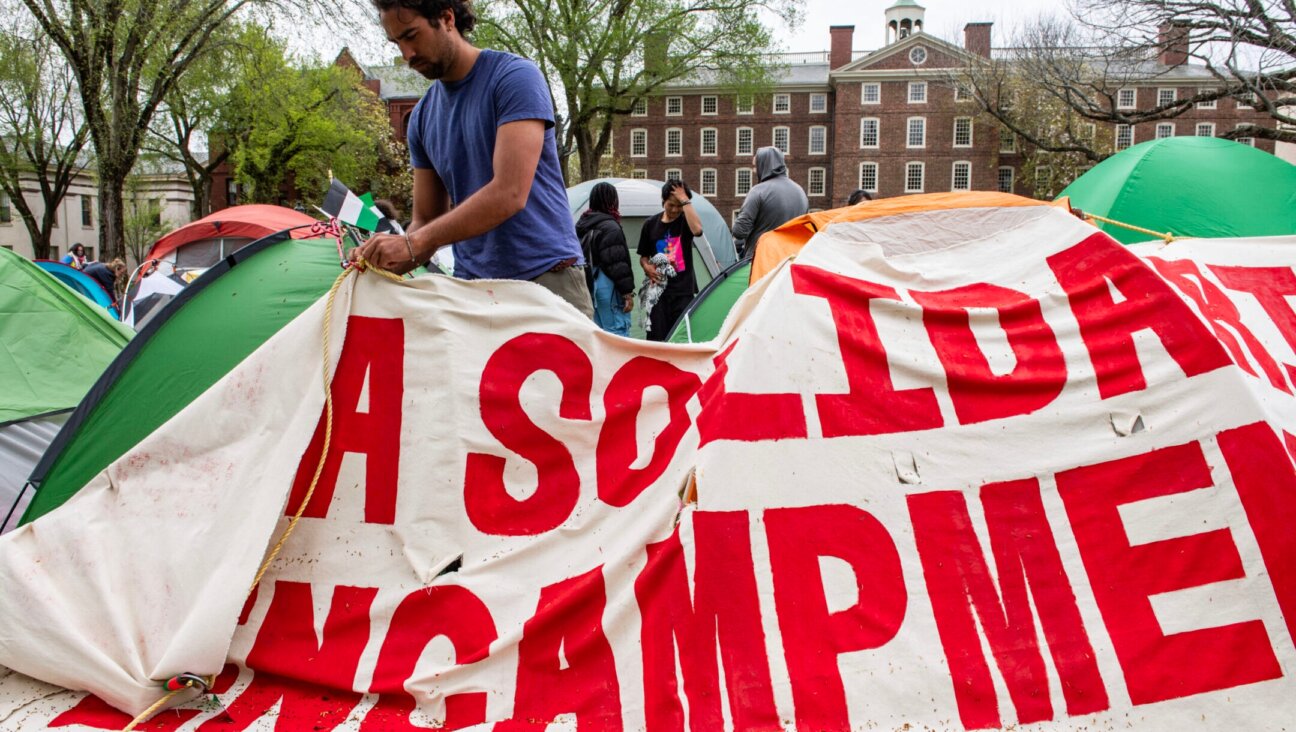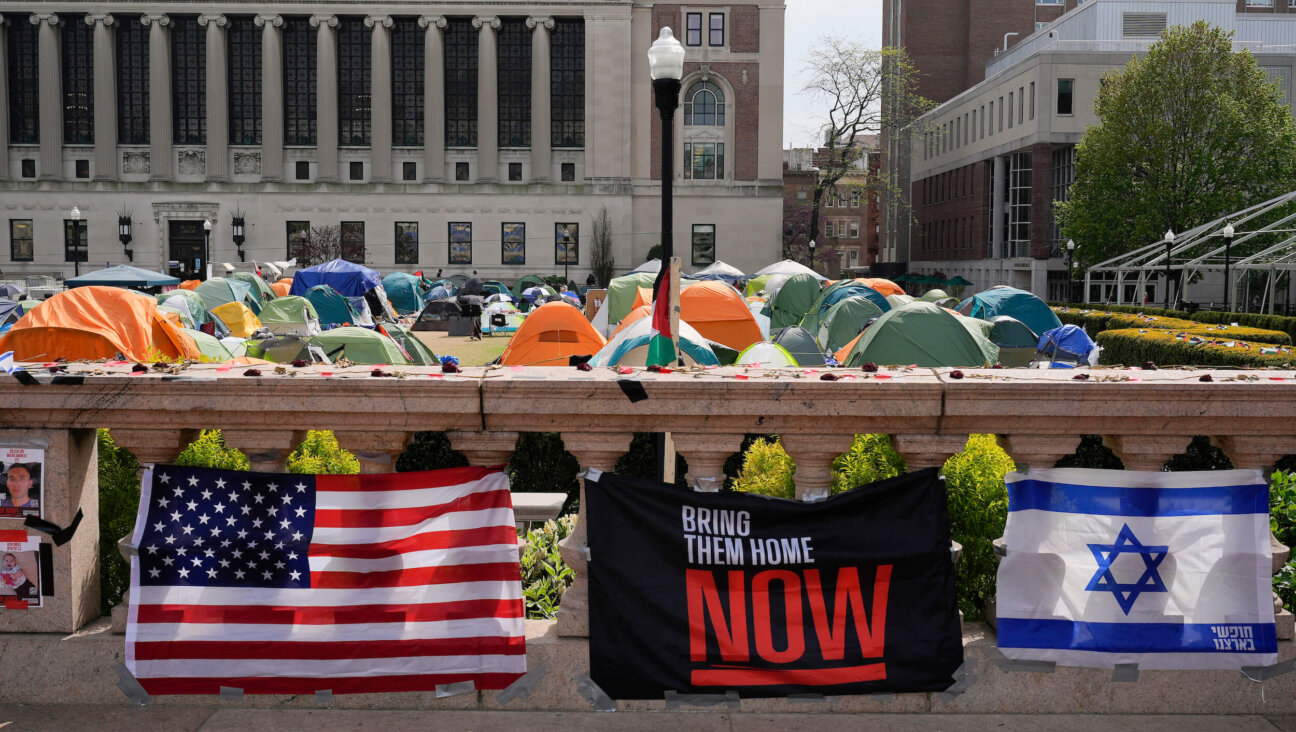Claims Conference Officials Were Told of Massive $57M Fraud — But Didn’t Act

German Finance Minister Wolfgang Schaeuble, right, and Julius Berman, chairman of the Conference on Jewish Material Claims Against Germany, sign an agreement to expand benefits to Holocaust survivors. Image by getty images
Top officials at the Jewish organization that processes Holocaust restitution claims were alerted to a fraud scheme being perpetrated by the group’s own employees nearly a decade before they moved to end it.
The fraud scheme, which went on for 15 years and diverted $57 million to unqualified recipients, was first described in a detailed letter sent to the Conference on Jewish Material Claims Against Germany in June 2001, the Forward has learned. But the organization’s most senior officials, who were shown or apprised of the letter, apparently accepted the explanations of the fraud scheme’s ringleader even though a preliminary investigation of the letter’s charges supported its allegations.
Semen Domnitser, the scheme’s ringleader, was convicted with two others May 8 on federal fraud charges in connection with the elaborate scheme, which involved recruiting individuals to apply for compensation as Holocaust survivors using falsified and, in some cases, forged documents. Claims Conference employees in on the scheme then approved the applications, enabling the claimants to receive restitution payments from the German government while the Claims Conference staffers took a cut.
This is an updated and expanded version of a story that first appeared online on May 14.
Altogether, 31 people have pleaded guilty or have been convicted on fraud charges in connection with the case, including Domnitser and his two co-defendants.
During Domnitser’s recent trial, Greg Schneider, executive director of the Claims Conference, testified about his “shock and disbelief” when he learned in 2009 of the wide-ranging fraud committed by his own employees.
But the letter, which was introduced as evidence in the trial, was referred to in two documents Domnitser copied to Schneider in 2001 in response to the allegations against him.
The unsigned 2001 letter, so detailed that it was most likely written by an insider, was sent to a Claims Conference office in Germany on letterhead that read “Association of Eastern Europaen [sic] Jews in America,” an unknown organization. The writers described themselves as “a group of elderly European Jews living in USA” who had applied for but been denied Holocaust reparations because they lacked documentary proof of their suffering or because they earned slightly more than the income threshold to be eligible.
“Even though it is a pity that we could not receive money, we understand the rules,” the authors said. But, in contrast, the letter writers claimed, “rules were broken for many office employees.” The letter accused Domnitser and another employee of approving Holocaust funds for Claims Conference employees and their relatives “when these applicants were totally non-eligible.”
The letter identified five cases that should never have been approved and detailed the simple procedures the Claims Conference could follow to verify their fraudulence. The letter even quoted the seven-digit case numbers assigned by the Claims Conference to each application.
As disclosed in testimony at the trial, the letter sparked a review by a Claims Conference staffer confirming that the five applications cited in the letter included false statements and apparently fraudulent documents. The Frankfurt-based Claims Conference staffer who conducted the review expressed serious concerns about Domnitser and several employees who had approved these applications.
But top Claims Conference officials decided not to inquire further into the claims of fraud after Domnitser denounced his accusers as “anonymous liars” and offered varied justifications for having approved the applications, including one case that he acknowledged contained false claims. None of the steps the letter writers urged for verifying their allegations was pursued.
The fraud continued until 2009 when Karen Heilig, a senior Claims Conference official, discovered two highly dubious applications within a few weeks. The Claims Conference then hired the law firm Proskauer Rose to investigate further, and a few weeks later contacted the FBI.
Federal investigators would later discover a fraud about 15 years long, perpetrated by almost a dozen current and former Claims Conference employees with the help of many more runners and recruiters in the Russian-speaking community. Using forged documents and fake persecution stories, Claims Conference workers submitted and approved about 5,000 fraudulent claims totaling about $57 million from funds set up by the German government, primarily to care for the neediest Holocaust survivors.
Schneider testified in court in April that he was the Claims Conference’s chief operating officer, the organization’s No. 2 executive position, in 2001, when the letter was received. A lengthy profile of him published by the news service JTA last July also described him as holding that senior position then. But a spokesman for the Claims Conference later said that Schneider had made an error and that he was only assistant executive vice president, a lower post.
Schneider declined to respond on the record to inquiries from the Forward about why the organization’s top managers decided not to pursue the allegations brought to their attention then. So did Gideon Taylor, who was then the group’s executive vice president.
In a statement to the Forward, Claims Conference spokeswoman Hillary Kessler-Godin emphasized that the organization had thoroughly reviewed how the fraud “was committed, who was involved, and ways in which it can be avoided in the future.”
“Fortunately, the fraud case is now over,” Kessler-Godin added. “All the participants in the fraud have now been found guilty and we consider this matter closed.”
The anonymous letter’s reappearance comes at a particularly difficult moment for the Claims Conference, which has faced increased pressure recently from critics who point to the fraud as a symbol of what they perceive as a lack of oversight and accountability at the organization.
In a recent Jerusalem Post article, Isi Leibler, a former World Jewish Congress official, criticized the Claims Conference’s board of directors for failing to launch an independent review to “establish the facts” of the fraud and for approving a board resolution expressing “complete confidence in the leadership and management of the Claims Conference.” Leibler termed the board’s action a “contemptuous rejection of all managerial accountability.”
Andrew Baker, a member of the Claims Conference board, said he did not believe that he was ever made aware of the letter. Baker said the fraud had been presented to the board as something that only came to the attention of senior staff in 2009.
“I think in hindsight it was obviously a mistake and more could have been done and should have been done,” Baker said. “[We] don’t know what other things [were] on [Claims Conference officials’] desks at the time… we’re being asked to judge their judgment 12 years ago. I’m not sure how fair that request is.”
Baker stopped short of calling for an independent investigation into how the letter’s allegations were handled by Claims Conference officials in 2001. Nevertheless, he said that as a “longtime board member” he would be interested in knowing more. “Not necessarily because that would lead me to change my view or judgment of [the Claims Conference’s] professional leadership,” he added.
[Samuel Norich, publisher of the Forward and president of the Forward Association, is also a member of the Claims Conference board representing the Jewish Labor Committee. He declined to speak on the record. The Claims Conference gave a grant of $22,500 to the Forward in 2010, according to the Claims Conference’s publicly available tax records.]
In the absence of an explanation from Claims Conference executives, it is unclear why the Claims Conference investigation failed to uncover Domnitser’s deceptions. But the anonymous letter, sent on June 6, 2001, is strikingly prescient in predicting some of the major players in the fraud and how they could easily have been unmasked.
The letter was sent to Hannalore Diedrich, director of the Claims Conference’s logistical center in Frankfurt. The center is the final checkpoint for applications before claims are paid out by the German government.
As made clear in testimony at Domnitser’s trial, Diedrich in turn passed the letter to Julia Gafsi, who was then a caseworker in the Claims Conference’s Frankfurt office.
Gafsi testified at the Claims Conference trial that she was given the anonymous letter and instructed to assess each of the highlighted cases. “I was not told to do any research,” Gafsi told the court. “I was told to make an analysis based on documents on file.”
Gafsi found myriad problems with the applications.
Polina Berenson, a Claims Conference caseworker, claimed in her application to have spent the war in a ghetto, but there was no documentary proof to back up the claim in her file.
Berenson’s sister, Mariya Fortel claimed in an application for one Holocaust fund to have fled during the war from Kazatin, Ukraine, to Kazan, Russia, “where we lived during the war in terrible conditions.” Three years later, Fortel applied for another fund, saying that she had spent the war imprisoned in a ghetto in Bershad, Ukraine.
Other cases relied on documents that could easily have been forged, or on paperwork that appeared to have been doctored. In several cases, the applicants’ household income was above the threshold. “There were discrepancies that should have been clarified, there was documentation missing,” Gafsi told the court.
Gafsi, who today is the director of claims processing at the Claims Conference, put all of her findings together in a chart. On receiving this, Karl Brozik, who was director of Claims Conference operations in Germany, faxed a copy of the anonymous letter and of Gafsi’s chart to Domnitser on June 21, copying Taylor and Saul Kagan, the Claims Conference’s previous executive vice president.
Later that day, Domnitser responded to Brozik by fax, saying that it would take him a couple of days to assemble the materials that “will prove that our decisions on these cases were correct.” Domnitser added that the letter’s authors appeared to be “a totally fictitious entity that covers the Claims Conference haters.” He copied Taylor, Kagan and Schneider on his response.
Domnitser wrote to Brozik again June 28, copying Taylor, Kagan and Schneider on his reply.
“I don’t believe that you expect me to participate in the discussion regarding the truth and the validity of the accusations, expressed by [the letter’s authors],” Domnitser wrote Brozik. “In the present situation, it’s not up to me to pass judgment whether ‘the rules were broken’ and whether ‘the documents were perjured.’ Besides, it’s also absolutely useless, in general, to argue with anonymous liars.”
Domnitser proceeded to try to answer the questions raised by Gafsi. Of the five claims that were queried, Domnitser said that he would suspend payments “pending further investigation” for just one.
Domnitser gave various reasons to account for conflicting witness statements and to explain why information or documentary proof was either insufficient or missing from files.
To explain how an applicant could claim to have fled during the war and also to have been imprisoned in a ghetto, Domnitser wrote that “as [with] many others, the applicant was badly advised and filed [a Holocaust fund] claim on false pretense.” Domnitser said that at a Claims Conference staff meeting in New York, in 1999, it was decided that so-called “double-version cases of this kind are to be approved.”
Kessler-Godin did not respond to an email from the Forward asking whether this was or remains Claims Conference policy.
In response to Gafsi’s assertion that a birth certificate submitted by a Claims Conference employee might have been forged, Domnitser said, “The copy of the birth certificate has been signed by me, which means that I saw the original with my own eyes on the day specified.”
At the Claims Conference trial, Gafsi said Domnitser’s response was insufficient.
The anonymous letter said that some of the applications could be revealed as fraudulent easily if the Claims Conference submitted fresh requests for the applicants’ Red Cross documentation and birth certificates. But that does not appear to have been done. (After the fraud was discovered in 2009, such requests revealed the documents were, indeed, forged, including the birth certificate Domnitser claimed to have seen.)
On May 14, after the Forward published allegations regarding the letter on forward.com, Kessler-Godin blamed the failure of the investigation on Brozik, who died in 2004.
“The entire investigation in Germany, directed by Dr. Brozik (who was senior to Greg at the time), was never shared with Greg,” Kessler-Godin wrote.
“The entire investigation that occurred did not include Greg and involved people senior to him.”
Using a variant spelling of Domnitser’s first name, Kessler-Godin, stated, “Dr. Brozik in Germany accepted Semyon’s explanations for the cases cited in the anonymous letter.”
Kessler-Godin also said that “the only document [Schneider] received, as a third cc, was the explanation from Semyon.” In fact, Schneider was copied on two faxes from Domnitser challenging the letter’s assertions.
Kessler-Godin added: “It challenges [the] imagination to believe that the person, Greg, who immediately and determinedly investigated when he received hints of fraud in 2009, would have been privy to these documents and not reacted the same way in 2001.”
At around the same time that the Claims Conference was dealing with the anonymous letter, Kirsten Schlueter, another employee in the logistical office, was also having trouble with applications from Domnitser’s office.
At the recent trial, Schlueter told the court that Claims Conference offices in Tel Aviv, New York and Frankfurt regularly complained that the logistical center processed claims too slowly. But only the New York office complained “that we were asking too detailed questions.”
“I remember [in] one situation that there were massive complaints from New York, and that my supervisor [Diedrich] was called in by her supervisor [Brozik] and was requested to stop this questioning from our part,” Schlueter told the court.
Schlueter said that at a senior staff meeting in New York, in May 2002, Domnitser berated Diedrich in front of her colleagues for slowing down claims. “[Diedrich] was well, somewhat shocked, because it appeared to be a form of discrediting in front of the whole staff,” Schlueter told the court.
Following that meeting, Diedrich confronted Domnitser in his office about the questionable applications that had been highlighted by the anonymous letter the previous year. Schlueter, who acted as Diedrich’s interpreter during that exchange, recalled that Diedrich asked for “a signature of somebody higher up from Mr. Domnitser” in order to continue paying the claims.
Schlueter said it was a normal request to make where claims involved Claims Conference employees and their relatives, but Domnitser dug in his heels. “Mr. Domnitser’s reply was that it was not necessary because everything was in order,” Schlueter recalled.
She added: “[Diedrich] did not really agree, but she did not pursue the matter.”
Contact Paul Berger at [email protected]

I hope you appreciated this article. Before you go, I’d like to ask you to please support the Forward’s award-winning, nonprofit journalism during this critical time.
Now more than ever, American Jews need independent news they can trust, with reporting driven by truth, not ideology. We serve you, not any ideological agenda.
At a time when other newsrooms are closing or cutting back, the Forward has removed its paywall and invested additional resources to report on the ground from Israel and around the U.S. on the impact of the war, rising antisemitism and the protests on college campuses.
Readers like you make it all possible. Support our work by becoming a Forward Member and connect with our journalism and your community.
Make a gift of any size and become a Forward member today. You’ll support our mission to tell the American Jewish story fully and fairly.
— Rachel Fishman Feddersen, Publisher and CEO
Join our mission to tell the Jewish story fully and fairly.

























